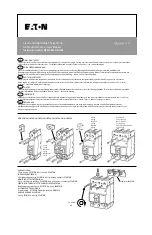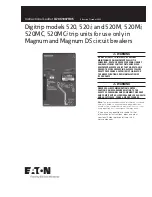
32
EATON
www.eaton.com
Signal contact output
General use
Alarm
Fault tripping
Self-diagnosis alarm
Instantaneous fault
Ground / residual current fault
Overload pre-alarming
Overload fault
Short delay time fault
Under voltage fault
Over voltage fault
Ground alarm
Current imbalance fault
Neutral line fault
Demand fault
Reverse power fault
Voltage imbalance fault
Under frequency fault
Over frequency fault
Phase sequence fault
MCR fault
Short circuit interlocking
Closing
Opening
Demand over-limit
Phase A demand fault
Phase B demand fault
Phase C demand fault
Phase N demand fault
otes:
N
General use means that the input/output is not used in the controller itself, and can be operated by the host computer in the communication group.
Contact default setting
Contact 1
Contact 2
Contact 3
Contact 4
PXR4.1/PXR6.1
Load monitor 1
Load monitor 2
Self-diagnosis fault alarm
Fault tripping
PXR4.1/PXR6.1 with communication
Load monitor 1
Load monitor 2
Remote opening
Remote closing
PXR4.1 intelligent controller MODBUS-RTU
communication protocol
1. Protocol overview
1.1. Physical layer
Transmission method: RS485
Communication address: 1-255
Communication baud rate: 9600BPS, 19200BPS
Communication distance: Up to 1000 meters
Communication medium: Shielded twisted pair
Communication protocol: MODBUS-RTU
1.2. Link layer
• Transmission method: host-slave half-duplex mode.
First, the signal from the host is addressed to a unique terminal
device (slave device), and then the response signal from the
slave device is transmitted to the host in an opposite direction.
The protocol allows data exchange only between the host and
slave device, rather than between independent slave device.
This will ensure the communication line not to be occupied
during initialization, which is only restricted to respond to query
signals that arrive at the device.
• A data frame format
1 start bit, 8 data, 1 stop bit, and no check bit.
Address
Function code
Data
Check code
8-Bits
8-Bits
N x 8-Bits
16-Bits
• A data packet format
The protocol defines check code and data sequence in great
detail, which are essential for specific data exchange.
Upon arrival at a slave device, the data frame enters into the
addressed device through a simple “port”. The device then
removes the “envelope” (data header) of the data frame, and
reads the data. If no error, the device executes the command
requested by the data. It adds the data it generates into the
obtained “envelope”, and returns the data frame to the sender.
The returned response data contains the slave address (Address),
executed command (Function), requested data (Data) generated
by the executed command, and a check code (Check). The slave
device can identify the error communication from the host and
give different error responses.
Instruction Leafl et
Effective September 2022
IZM6 Series Air Circuit Breaker
Operating Instruction Leafl et


































